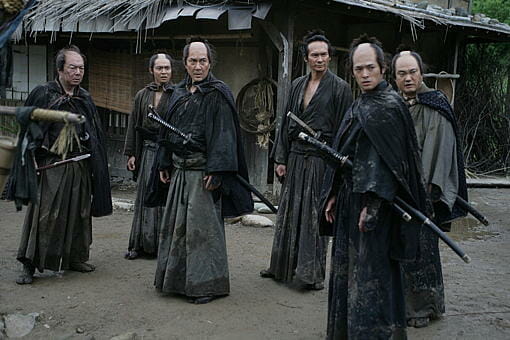By Andrew Watson · May 8, 2011

13 Assassins is a film that has a very conflicted relationship with violence. Naturally, being a Takashi Miike film, it is teeming with it. Its opening scene depicts a man committing Harikari (a ritual suicide) after being wronged by Lord Naritsugu (Goro Inagaki), and this complicated and painful procedure invokes questions in the film almost instantly. What would cause someone to put himself through such an agonizing act?
The answer is Lord Naritsugu. A vicious and cruel younger brother of the ruling Shogun, he places himself as the bad guy early on in the piece by being nothing less than an absolute bastard. Rape, murder, mutilation are witnessed in a harrowing and shocking opening twenty minutes. An aging Samurai called Shinzaemon (Koji Yakusho) is called by a government official to hear these horror stories and through dialogue, the film gives the bad guy even more weight. As the shoguns younger brother, he is above the law. Shinzaemon is given his mission: assemble a team to kill Naritsugu.
13 Assassins demonstrates a valuable lesson in how attention to detail can make an image say much more than over the top bravado or a long bout of exposition. Naritsugu is introduced in a single shot in which a servant assists him in taking a leak while he stands there with absolute authority as his army waits patiently behind him. The rather disgusting task that he forces his servant to carry out is not just an indication of the kind of depravity he will indulge in later, but also serve to show in a single image his convictions and values. He is the kind of man who believes in servitude to the extreme. And this small shot might not seem like much, compared to all the violence that Naritsugu commits around it, but it is significant none the less.
Compare this with the good guy. While Naritsugu has placed himself as different to everyone, as a superior to the world around him, Shinzaemon’s introduction is the complete opposite; sitting on a lake fishing surrounded by strangers dressed almost exactly the same, giving an image of a man who doesn’t see himself as different to anyone else. These might seem like small details, but the sheer volumes of inferior films that focus instead on over the top bravado and in which these details are not present, only underscores that these little touches give the film depth, and move characters beyond mere stereotypes.
What unfolds after the opening 20-minute salvo is a gripping Samurai film that takes Miikes career in an entirely new direction. The one criticism Miike has had over his long career is that his films all tend to draw an extremely fine line between critique of a subject through horror, and downright exploitation. Miike has always been quick to point out his violence is never anything more than comical, that it’s extreme to the point of parody (just look at Ichi the Killer). 13 Assassins is the first step to creating something more mature than his previous works, taking most of the violence off screen and allowing the meaning behind it to take centre stage.
That is not to say that he doesn’t pander to his ethos of violent excess. The final 45 minutes are an entire battle, in which Miike throws absolutely everything he can at the audience, including cows on fire, and several different and beautifully crafted sword fights all linked together to create a giant set piece. It is brilliant and inventive, and certainly pays the audience back three fold for its faith in a long and meticulous set up. It does however do too much, throwing a mass of good ideas but with a lack of restraint: 45 minutes is an awful lot of time to throw swords at people. It’s commitment to such a long battle also suffers as it tries to break the fighting up with talk between the 13 assassins, which leaves you in this strange position of watching them pretty much stop fighting while surrounded by swordsman. Miike also occasionally crosses the line into exploitation, with the harrowing opening of the film feeling overdone. The film tries to make its point by following the rule of three, and show three different despicable acts by Naritsugu. While it does manage to paint him as the absolute bastard of the piece, again, too much is thrown onto the screen.
Ultimately though, Miike manages to create a much more mature piece than the work which has brought him fame as well as notoriety, and with his next film already completed we may see the return of the classic Samurai films of the 60s.